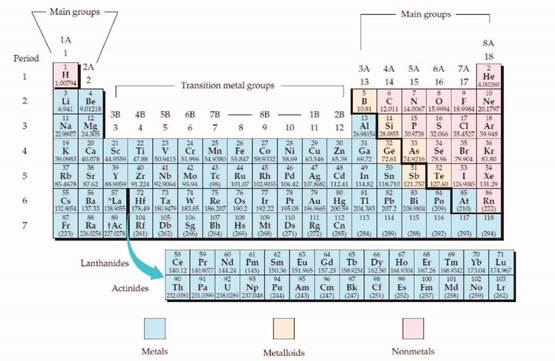
Interpretation:
The group should be identified when the valance shell configuration is
Concept introduction:
The periodic table is given below,

The electron configuration is the distribution of electrons of an atom or molecule in atomic or molecular orbitals. Atom consists of s, p, d, and f orbitals.
The Aufbau principle:
The Aufbau principle is states that in the ground state of an atom, electrons fill atomic orbitals of the lowest available energy levels before occupying higher levels. For example, the 1s shell is filled before the 2s subshell is occupied.
The subshell ordering by this rule is
Want to see the full answer?
Check out a sample textbook solution
Chapter 2 Solutions
Fundamentals of General, Organic, and Biological Chemistry (8th Edition)
- A principal shell with a value of n=3 would contain s,p,d, and f orbitals true or falsearrow_forwardAnother major use of bismuth has been as an ingredient in low-melting metal alloys, such as those used in firesprinkler systems and in typesetting. The element itself is a brittle white crystalline solid. How do these characteristicsfit with the fact that bismuth is in the same periodic group with such nonmetallic elements as nitrogenand phosphorus?arrow_forwardArrange in order of increasing nonmetallic character (a) the period 3 elements Na, Cl, & Mg (b) the Group 7A elements At, F, & Iarrow_forward
- Why is it not possible to find a five-fold symmetry operation in naturally-occurring crystals?arrow_forward(1) Identify the chiral atoms, if any, with an asterisk (*) in the following compounds. HO Н CH OH Н ОН H Н ОН Н ОН Н HO CH OH Н ОН Н Н ОН Н ОНarrow_forwardWhat if there are a different number of Neutrons? Sometimes elements have a different number of neutrons than usual, so therefore have a different atomic mass. This is what we call an Isotope (a variant form of an element which has the same number of protons but a differing number of neutrons). Sometimes we’ll see Isotopes labeled with their new mass like this: 14C = this is Carbon 14. Notice it has a different mass than what is on your periodic table The average mass of all the isotopes is defined as an element’s Atomic Weight. Can you answer questions about these Isotopes? ELEMENT ATOMIC MASS NUMBER OF PROTONS NUMBER OF NEUTRONS 14C A B C 15N D E F 2H G H I Use your table to look up the number of protons, remember that never changes!arrow_forward
- What is structure formula of:arrow_forwardHow many of the carbons in the following structure are stereocenters?arrow_forwardElemental analysis of a compound with molar mass 342.3 g/mol gives the following mass percent composition: C 42.11%, H 6.48%, O 51.41%. Find the molecular formula of the compound. Enter your answer in the space below using the following format: if the molecular formula of a compound containing elements X, Y, and Z is X2YZ3 enter your answer as X2YZ3.arrow_forward
- What structures are labeled 1 in the diagrams? What structure is labeled 2 in the diagrams? What is labeled 3 in both diagrams? What is labeled 4 in the diagrams? What is labeled 5 in the diagrams?arrow_forwardI Review | Constants | Periodic Table You may want to reference (Page) Section 9.5 while completing this problem. Propane (C3 H8) burns in oxygen to produce carbon dioxide and water via the following reaction: C3HS (g) + 502 (g)→3CO2 (g) + 4H,0(g) Part A Calculate the mass of CO2 that can be produced if the reaction of 37.3 g of propane and sufficient oxygen has a 56.0 % yield. Express your answer with the appropriate units. l'i HẢ ? m(CO,) = Value Units Submit Request Answer Provide Feedback Next >arrow_forwardWhy do the 3s, 3p, and 3d orbitals have the same energy in a hydrogen atom but different energies in a many- electron atom?arrow_forward

 Principles Of Radiographic Imaging: An Art And A ...Health & NutritionISBN:9781337711067Author:Richard R. Carlton, Arlene M. Adler, Vesna BalacPublisher:Cengage Learning
Principles Of Radiographic Imaging: An Art And A ...Health & NutritionISBN:9781337711067Author:Richard R. Carlton, Arlene M. Adler, Vesna BalacPublisher:Cengage Learning

